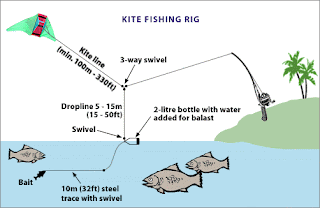
Procedure:
1. Make up components as individual units, dropline, bottle, bait and trace etc. Use snap swivels for easy attachment.
2. Set up Skymaster and adjust bridle ring until desired angle of attack is achieved. You do this by loosening the larks head knot and sliding the line through the ring and then tightening the knot again. Shortening the left-hand bridle line will make the kite tack to the right and vice-versa. Make small adjustments and fly the kite and keep adjusting until you are satisfied. Let out all the kite line and remove the line from the reel and attach a snap swivel on the end.
3. Now clip the kite line onto the 3-way swivel, which in turn is attached to the fishing reel, drop line, bottle and bait. You will now be controlling everything from the reel.
4. Begin to let out line from the fishing reel taking up the slack from the drop line until you can release the bottle. This is a good time to check that the kite is behaving properly.
5. Keep letting out line from the reel until the bottle, and bait, is the desired distance from shore, this is usually 200m - 500m (650ft - 1,650ft).
NOTE: Don't make the drop-line and trace longer than you can back up on land, otherwise you may not be able to get the fish close enough to gaff. Kite fishing alone is not easy so have a helper at hand.

When I was a kid, one of the favorite summer pastimes was kite flying. We would spend hours adding just enough tail to keep the kite straight, but not so much that it would not reach some altitude. We would ride bicycles with the kite string tied to our waste and the kite suspended in the air 30 or 40 feet above and behind us. On calm days we would run sometimes an entire city block trying to launch our kite.
I still enjoy kite flying, only these days it is from the stern of a boat! And the kites I fly today are a far cry from the newsprint and balsa wood versions we used to make. These high tech kites I use are for one purpose, and that is to catch fish.
The method is relatively easy. It just takes a little practice to keep the boat motion either with the engine or with a drift such that the kite remains in the same relative vertical space all the time.
The kite acts as an outrigger of sorts, although you might better name it and "up" rigger.
The kite is launched and flown from the stern of a boat, usually on a line from a special rod and reel. The fishing line is attached at the kite similar to an outrigger, only instead of keeping the line out, it keeps it up. Boat speed
determines where the bait is in the water.
Usually a slow troll or drift, this fishing is designed for live bait. A live blue runner, or ballyhoo, or other bait fish is suspended from the kite right on the surface of the water. The bait's attempts to get below the surface
coupled with the motion of the kite keep the bait in and out of the water, right on the surface. It really drives billfish in the area crazy!
But don't be fooled into thinking that this is strictly a billfish tactic. King mackerel, cero mackerel and occasionally wahoo are also caught from kite rigs. My fishing partner has even caught yellowfin and blackfin tuna from his kite.
Any one can use this method. The expense involved is minimal, even for the special designed fishing kites. Many fishermen make their own kites to save money, but when they are made from paper, they usually don't last through the first day. So, a vinyl kite made for fishing is recommended. Simply catch your live bait, get to the area you would normally be trolling, and dangle a live bait on the surface under a kite. A nice lazy way of spending a day - no hard fishing, no weeds to clear from the bait, and a whole lot less gasoline used.
No comments:
Post a Comment